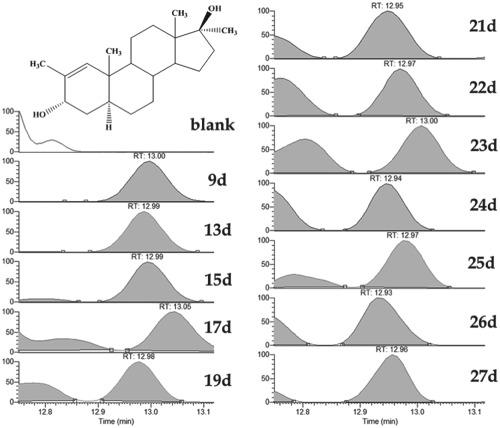当前位置:
X-MOL 学术
›
Drug Test. Anal.
›
论文详情
Our official English website, www.x-mol.net, welcomes your feedback! (Note: you will need to create a separate account there.)
Studies on the in vivo metabolism of methylstenbolone and detection of novel long term metabolites for doping control analysis.
Drug Testing and Analysis ( IF 2.9 ) Pub Date : 2019-12-08 , DOI: 10.1002/dta.2736 Thomas Piper 1 , Gregor Fusshöller 1 , Wilhelm Schänzer 1 , Andreas Lagojda 2 , Dirk Kuehne 2 , Mario Thevis 1, 3
Drug Testing and Analysis ( IF 2.9 ) Pub Date : 2019-12-08 , DOI: 10.1002/dta.2736 Thomas Piper 1 , Gregor Fusshöller 1 , Wilhelm Schänzer 1 , Andreas Lagojda 2 , Dirk Kuehne 2 , Mario Thevis 1, 3
Affiliation

|
The anabolic‐androgenic steroid methylstenbolone (MSTEN; 2α,17α‐dimethyl‐17β‐hydroxy‐5α‐androst‐1‐en‐3‐one) is available as a so‐called designer steroid or nutritional supplement. It is occasionally detected in doping control samples, predominantly tested and confirmed as the glucuronic acid conjugate of methylstenbolone. The absence of other meaningful metabolites reported as target analytes for sports drug testing purposes can be explained by the advertised metabolic stability of methylstenbolone. In 2013, a first investigation into the human metabolism of methylstenbolone was published, and two hydroxylated metabolites were identified as potential targets for initial testing procedures in doping controls. These metabolites were not observed in recent doping control samples that yielded adverse analytical findings for methylstenbolone, and in the light of additional data originating from a recent publication on the in vivo metabolism of methylstenbolone in the horse, revisiting the metabolic reactions in humans appeared warranted. Therefore, deuterated methylstenbolone together with hydrogen isotope ratio mass spectrometry (IRMS) in combination with high accuracy/high resolution mass spectrometry were employed. After oral administration of a single dose of 10 mg of doubly labeled methylstenbolone, urine samples were collected for 29 days. Up to 40 different deuterated methylstenbolone metabolites were detected in post‐administration samples, predominantly as glucuronic acid conjugates, and all were investigated regarding their potential to prolong the detection window for doping controls. Besides methylstenbolone excreted glucuronidated, three additional metabolites were still detectable at the end of the study on day 29. The most promising candidates for inclusion into routine sports drug testing methods (2α,17α‐dimethyl‐5α‐androst‐1‐ene‐3β,17β‐diol and 2α,17α‐dimethyl‐5α‐androst‐1‐ene‐3α,17β‐diol) were synthesized and characterized by NMR.
中文翻译:

甲基斯坦酮的体内代谢研究和新型长期代谢物检测以进行兴奋剂对照分析。
合成代谢雄激素类固醇甲基酮勃龙(MSTEN;2α,17α-二甲基-17β-羟基-5α-雄激素-1-烯-3-酮)可作为所谓的设计类固醇或营养补品获得。偶尔在掺杂对照样品中检测到它,主要测试并确认为甲基斯坦勃龙的葡糖醛酸结合物。甲基体育酮的广告代谢稳定性可以解释为缺乏其他有意义的代谢物作为运动药物测试目的的目标分析物。2013年,发表了关于甲基斯坦酮的人体代谢的第一个研究报告,并且确定了两种羟基化代谢物作为兴奋剂对照初始测试程序的潜在目标。在最近的兴奋剂对照样品中未观察到这些代谢物,这些样品对甲基斯坦勃龙产生不利的分析发现,并根据最近发表的有关马匹中甲基斯坦酮的体内代谢的其他数据,看来有必要重新审视人体内的代谢反应。因此,采用氘代甲基斯坦酮与氢同位素比质谱法(IRMS)结合高精度/高分辨率质谱法。口服单剂量的10 mg双标记的甲基斯坦酮后,收集尿液样本29天。给药后样品中最多检测到40种不同的氘代甲基斯坦酮酮代谢物,主要是葡萄糖醛酸共轭物,并对所有这些物质延长了掺杂对照检测窗口的潜力进行了研究。除了甲基固酮酮分泌的葡糖醛酸外,
更新日期:2019-12-08
中文翻译:

甲基斯坦酮的体内代谢研究和新型长期代谢物检测以进行兴奋剂对照分析。
合成代谢雄激素类固醇甲基酮勃龙(MSTEN;2α,17α-二甲基-17β-羟基-5α-雄激素-1-烯-3-酮)可作为所谓的设计类固醇或营养补品获得。偶尔在掺杂对照样品中检测到它,主要测试并确认为甲基斯坦勃龙的葡糖醛酸结合物。甲基体育酮的广告代谢稳定性可以解释为缺乏其他有意义的代谢物作为运动药物测试目的的目标分析物。2013年,发表了关于甲基斯坦酮的人体代谢的第一个研究报告,并且确定了两种羟基化代谢物作为兴奋剂对照初始测试程序的潜在目标。在最近的兴奋剂对照样品中未观察到这些代谢物,这些样品对甲基斯坦勃龙产生不利的分析发现,并根据最近发表的有关马匹中甲基斯坦酮的体内代谢的其他数据,看来有必要重新审视人体内的代谢反应。因此,采用氘代甲基斯坦酮与氢同位素比质谱法(IRMS)结合高精度/高分辨率质谱法。口服单剂量的10 mg双标记的甲基斯坦酮后,收集尿液样本29天。给药后样品中最多检测到40种不同的氘代甲基斯坦酮酮代谢物,主要是葡萄糖醛酸共轭物,并对所有这些物质延长了掺杂对照检测窗口的潜力进行了研究。除了甲基固酮酮分泌的葡糖醛酸外,



























 京公网安备 11010802027423号
京公网安备 11010802027423号